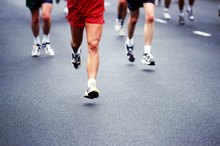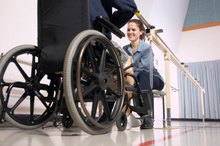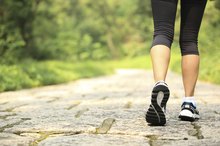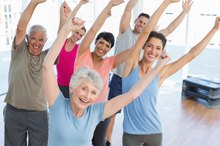Exercise for 66-Year-Olds
Exercise is crucial to health and having a full, active life at any age. While risk factors for illness and ailments increase with age, exercise can help offset those risks. Exercise can reduce the risk of hypertension, heart disease, diabetes, osteoarthritis and osteoporosis in seniors. Further, exercise improves balance to avoid injury and helps maintain cognitive function. Exercise is not without its risks, and seniors should check with their doctors for exercise recommendations and restrictions.
Cardiovascular Exercise
Seniors should get 30 minutes of cardiovascular exercise that raises the heart rate each day. However, for seniors who don't have the mobility or endurance, exercising a few minutes several times a day is allowed. Walking, swimming and water aerobics are healthy low-impact exercise options. Many gyms offer senior fitness classes, some of which are performed in chairs for people who have low mobility and range of motion or trouble with balance.
Strength Training
How to Strengthen the Patella Tendon
Learn More
Muscle-building exercises are important to maintain strength and mobility, as well as bone density. AgingCare.com recommends that seniors perform one to two sets of 10 to 15 repetitions of weight bearing exercises two to three times a week. While dumbbells are effective, other strength training equipment can be used, such as resistance bands or machines. Seniors can perform pushups against a wall and squats by sitting in a chair and then standing.
Flexiblity Exercises
Flexibility is important to senior health. It helps maintain range of motion, prevents injury and assists in muscle recovery after exercise. Maintaining flexibility in the hips helps with balance and prevents falls. Stretching can be done while sitting in a chair for seniors with low mobility and flexibility. Senior yoga classes provide stretching and strength building.
Balance Exercises
Quadriplegic Exercises
Learn More
The National Institute on Aging reports that more than one-third of people age 65 or older fall each year. Injuries related to falls can negatively impact an older person's life by limiting mobility and independence. Cardiovascular exercise, strength training and flexibility all assist with balance; however, seniors should perform balance-specific exercises as well. Standing on one leg, side leg lifts and walking heel to toe are common balance exercises. Seniors with poor balance should perform balance exercises near a wall or chair to prevent falling. Seniors with good balance can challenge themselves by doing balance exercises that shift the center of gravity. For example, stand on one leg with the lifted leg extended in front. Slowly move the extended foot until it's at your side.
Related Articles
References
Writer Bio
Leslie Truex has been telecommuting and freelancing since 1994. She wrote the "The Work-At-Home Success Bible" and is a career/business and writing instructor at Piedmont Virginia Community College. Truex has a Bachelor of Arts in psychology from Willamette University and a Master of Social Work from California State University-Sacramento. She has been an Aerobics and Fitness Association of America certified fitness instructor since 2001.









